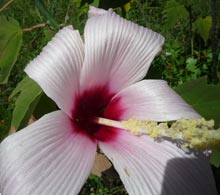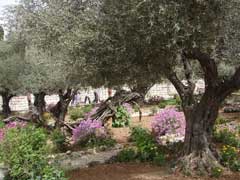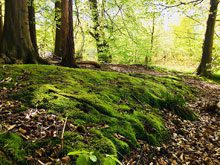 I’d like you to meet the Mallow family. They are a handsome bunch and will add daily interest and color to your perennial and shrub beds during the summer and fall.
I’d like you to meet the Mallow family. They are a handsome bunch and will add daily interest and color to your perennial and shrub beds during the summer and fall.
While the most cultivated Hibiscus are tropical, Hibiscus rosa- senensis, there are also some native species that can be found blooming along roadsides in coastal South Carolina and Georgia maritime forests, ditches, swales and marshes. Many of these are grown as ornamentals and can be purchased as hardy hibiscus. Malvaceae (mallow), a large family of herbs, shrubs and a few trees, also includes the familiar agronomic and vegetable crops: cotton Gossypium barbadense and okra Abelmoschus esculentus. Other roadside attractions are the Scarlet rose mallow a.k.a. swamp hibiscus, Hibiscus coccineus, and swamp rose mallow (also called wild cotton), Hibiscus moscheutos. Kostelezkya virginica, seashore mallow, is a perennial herb having several stems growing from a crown with thick roots. Seashore mallows can be found from Long Island to Texas and vary greatly in leaf forms and flower sizes and colors. They grow 5’ tall and petals can range from lavender pink to white. Rose of Sharon or Althea is probably the hardiest of the Hibiscus. They are not native to North America, but have naturalized quite well and are planted as small blooming trees. The tubular flowers with pronounced stamens come in many shades of white, purple and pink and are often visited by hummingbirds, butterflies, and bees for their nectar and ample pollen stores. There are also named varieties of Rose of Sharon which have double petals.
Mallows have leaves which resemble maples and are simple, alternately arranged, palmately lobed or dissected, with toothed or serrated margins. They have star shaped hairs (pubescence) which give leaves on my large pink hardy hibiscus the feel of velvet. The floral parts are in fives: Five sepals, five petals. The fruit is nearly always a capsule containing the seeds. Think okra. As gardeners we are all about the flowers, but plants are in it for reproductions and that is one place where this family of plants is putting out quite a display. The centers of the showy flowers are some of the most sensuous purples, crimsons, and pinks. The male flowering parts are numerous and form a long tube which surrounds the ovary and styles. The petals can be singular or united at the base and are the consistency of crepe paper. Most flowers only last a day and then dry into a capsule, which may contain one to many seeds. The small red flower of Malvaviscus drummondii Turk’s cap, never fully opens. It is found in many of the old gardens in Beaufort and naturalizes quite well.
Another weedy member of the family that has naturalized from another continent is a very common weed in my yard. Sida rhombifolia is about 2’ perennial with tough stems and small yellow flowers. It does great in my poor sandy soil and has tried to take over. I was recently introduced to the native species Sida elliottii. This rare species is named for Beaufort botanist Stephen Elliott, and it has a lovely and slightly larger yellow orange corolla. The Savannah hibiscus, Hibiscus aculeatus, is another one with creamy yellow corolla and a crimson center found in pine savannahs and maritime forests in the coastal plains of South and southern North Carolina.
A real southern favorite hardy hibiscus would be the Confederate roses. Hibiscus mutabilis ‘rubrum’ is the single dark pink variety, but the double H. mutabilis can grow upwards of 10’, branching out from a crown and reliably hardy roots. Each morning double flowers bloom, bigger than a softball, clear bright white becoming dark pink by late afternoon. It is common to see large trees with all shades of pink blooms in October all across the state. The branches root in water quite easily, and I have grown plants from seed successfully, making this a great “pass along” plant. The only downside is they also are attractive to whiteflies, and care should be taken to give them a good spritz with the water hose when conditions are too dry and hot.
The Mallow family is such an interesting group and should be a great addition to naturalized areas of the garden. For the most part they enjoy moisture so consider using them in rain gardens or where they can get regular irrigation.
For photographs of many of the native and naturalized species visit http://www.namethatplant.net/4DCGI/QueryByFamily
For local sources of native plants visit www.scnps.org







